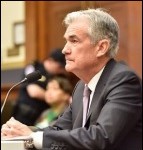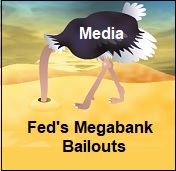-
Recent Posts
- Trump’s “Big Beautiful Bill” Is a Grotesque Giveaway to Fossil Fuel Billionaires While Adding $3.3 Trillion to Nation’s Debt
- Senator Chris Murphy Charges that Trump “Has Opened a Channel for Bribery”
- Congressman Casten: Trump’s Assault on the Rule of Law Is Causing Capital Flight Out of U.S. by Foreign Investors
- Trump’s Approval Rating Drops to 80-Year Low; IMF Says U.S. Tariffs Now Exceed the Highs During the Great Depression
- Nasdaq Has Lost More than 3,000 Points Since Trump’s First Full Day in Office in 2025; the Pain Has Barely Begun
- The Bond Crisis Last Week Was a Global No-Confidence Vote in U. S. President Donald Trump
- Trump’s Tariff Plan Guts $5 Trillion in Stock Value in Two Days; Senator Warren Calls for Emergency Action Before Markets Open on Monday
- Trump’s Attacks on Big Law, Universities, and the Media Have a Common Goal: Silence Dissent Against Authoritarian Rule
- Trump Administration Gives All Clear to Laundering Money through Shell Companies and Bribing Foreign Officials
- Four Megabanks on Wall Street Hold $3.2 Trillion in Uninsured Deposits – Which May Explain Senator Schumer’s Pivot to the GOP to Stop a Government Shutdown
- Here’s What Came Crashing Down Yesterday for Trump’s “Genius” Guy, Elon Musk: Tesla Stock, Access to Twitter (X), His Years of Secret Calls with Putin
- After Banning the Associated Press, Trump Is Now Targeting Specific Journalists That He Wants to See Fired
- Closely Watched Atlanta Fed Model Predicts Negative U.S. Growth in First Quarter
- Trump’s Gangster Diplomacy Makes Front Page Headlines Around the Globe
- Who Benefits Alongside Elon Musk If He Succeeds in Killing the CFPB: the Megabanks on Wall Street that Underwrite His Tesla Stock Offerings
- In Trump 1.0, the State Department Used Taxpayer Money to Publish a Book Elevating Elon Musk to a Superhero; It Was Funded by USAID, the Agency Musk Wants to Quickly Shut Down
- News Host Joy Reid Raises Threat of Trump Selling U.S. to Putin; Ten Days Later Her Show Is Cancelled
- Elon Musk’s DOGE Appears to Be Violating a Court Order; It Has Taken Down Hundreds of YouTube Videos that Educate Americans on How to Avoid Being Swindled
- Barron’s Releases Audio of Jamie Dimon Cursing Out His Workers at a Town Hall, as Dimon Plans to Dump Another One Million JPM Shares
- There’s One Federal Investigative Agency that Neither Trump nor Elon Musk Can Touch: It Just Opened an Investigation into DOGE
- Elon Musk’s Companies Were Under Investigation by Five Inspectors General When the Trump Administration Fired Them and Made Musk the Investigator
- Donald Trump Gives the Greenlight to Goldman Sachs and JPMorgan Chase to Return to Bribing Foreign Officials
- After Tech Geeks Built a Back Door to Loot Billions from FTX, Republicans Refuse to Investigate What Elon Musk’s Tech-Squad Did Inside the U.S. Treasury’s Payment System
- Former Prosecutor, Now U.S. Senator, Informs Tesla That CEO Musk May Be Violating Federal Law and to “Preserve All Records”
- Trump’s Hedge Fund Guy Is Now Overseeing the U.S. Treasury, IRS, OCC, U.S. Mint, FinCEN, F-SOC, and the Consumer Financial Protection Bureau
- As Elon Musk Begins Shutting Down Payments to Federal Contractors, a Strange Money Trail Emerges to His Operatives Inside the U.S. Treasury’s Payment System
- JPMorgan Chase Charged by Yet Another Internal Whistleblower with Cooking the Books
- We Asked Google’s AI Search Model, Gemini, Questions About the Fed and Wall Street Megabanks: It Got the Answers Dead Wrong
- With Trump and Melania’s Crypto Coins Likely to Raise Legal Challenges, Why Didn’t Trump Fire the SEC’s Inspector General in His Purge of IGs?
- Fossil Fuel Industry Could End Up Paying Tens of Billions for LA Wildfires and Deceiving the Public on Climate Change for Decades
- It’s Being Called the Biggest Grift by a President in U.S. History: Trump and First Lady Launch their Own Crypto Coins
- Trump Plans to Install a Fracking CEO to Head the Energy Department and Declare a National Emergency on Energy to Gain Vast Powers
- Fossil Fuel Money Played a Role in the Los Angeles Fires and the Push to Install Pete Hegseth as Secretary of Defense
- When It Comes to Wealth Retention in Retirement, Concrete May Be the New Gold
- Wall Street Watchdog Warns “Clock Is Ticking on a Coming Catastrophic Financial Crash”
- Wall Street Is Sending the Same Message to Americans on Fossil Fuel Financing that It Sent on Cigarettes: Drop Dead
- In a Six-Week Span, this Dark Pool with a Curious Past Traded 3.7 Billion Shares
- Wall Street’s Lobby Firm Hired Eugene Scalia of Gibson Dunn to Sue the Fed for Jamie Dimon
- Postmaster General Louis DeJoy Made $561,051 in Compensation in 2024, as Mail Costs Spiked and Delivery Deteriorated
- Fed Chair Jay Powell Sends a Bold Message to Trump and Tanks the Dow by 1123 Points
- The Head of Fixed Income at T. Rowe Price Makes the Scary Case for the 10-Year Treasury to Spike to 6 Percent
- $663 Billion in Cash Assets Have Gone Poof at the Largest U.S. Banks
- Donald Trump to Ring Bell at New York Stock Exchange Today as Hit List Posters Appear in Manhattan Targeting Wall Street CEOs
- Trump Has a Slush Fund to Prop Up the Dollar – Will He Use It to Prop Up Bitcoin Instead?
- A CEO Assassination; a Billionaire Heiress/NYPD Commissioner; a Secret Wall Street Spy Center – Here’s How They’re Connected
- Despite More than 1600 Tech Scientists Signing a Letter Calling Crypto a Sham, Trump Names a Crypto Cheerleader for SEC Chair
- The Fed Rings a Warning Bell: Hedge Funds and Life Insurers Are Reporting Historic Leverage
- Trump’s Nominee for FBI Director, Kash Patel, Has Businesses Financially Intertwined with Trump
- Donald Trump Is at Risk of Getting Named in a Fossil Fuels Conspiracy Lawsuit
- Trump Is Having Difficulty Getting a Lawyer to Accept the Nomination for SEC Chair: Here’s Why
Search Results for: Federal Reserve
What Has Frightened Wall Street Banks from Lending in the Repo Market?

By Pam Martens and Russ Martens: September 24, 2019 ~ Last Friday the Federal Reserve Bank of New York made it clear that its interventions in the overnight repo lending market were going to be a longer-term action. Call it what you will, the Fed has effectively returned to quantitative easing (QE) where it buys up Treasuries, Federal agency debt and agency mortgage-backed securities (MBS) from financial institutions in exchange for loans. According to the New York Fed, the program has now been extended to at least October 10 and likely thereafter in one form or another. The Fed will be pumping in $75 billion daily in overnight repo loans while infusing $30 billion in 14-day term loans three times this week for a total of $90 billion in term loans. The fact that there is one or more financial firms needing $30 billion on a two-week basis and can’t … Continue reading
JPMorgan Chase Has Billions in CRE Loans Riding on WeWork Surviving

By Pam Martens and Russ Martens: September 23, 2019 ~ WeWork’s business model isn’t workable. Everybody understands that except the Wall Street bank that has the most to lose if WeWork’s initial public offering (IPO) of its stock doesn’t move forward. That bank is JPMorgan Chase, one of the two main underwriters of the IPO, along with Goldman Sachs. WeWork’s business model is to take long-term leases in commercial office buildings and then sub-lease that space under short leases to small businesses, start-ups and freelancers – none of which are particularly known for their ability to pay rent in a downturn. WeWork is currently on the hook for more than $47 billion in long term leases while it has yet to figure out how to make a dime of profits. JPMorgan Chase is so interconnected with WeWork that to a number of minds WeWork looks like little more than a … Continue reading
The Fed’s “Emergency” Actions this Week Were Dated 48 Days Earlier

By Pam Martens and Russ Martens: September 20, 2019 ~ The storyline in the business press is that the lending rate on overnight repos had spiked to an unprecedented 10 percent, necessitating an emergency infusion of $53 billion by the New York Fed on Tuesday to ramp up liquidity for overnight loans and bring down the loan rate. (That was followed with $75 billion more on Wednesday, Thursday and today – raising the question that if the money is going to the same banks, isn’t that a term loan, not an overnight loan? We don’t know, however, if the money is going to the same banks because the Fed, as it did during the 2008 financial crisis, is staying mum about where the money is going.) As it turns out, the Federal Reserve’s Federal Open Market Committee (FOMC) directive that authorized the Tuesday operation was dated July 31, 2019 – … Continue reading
At Press Conference, Fed Chair Powell Refuses to Answer Whether Wall Street Banks Are Too Big to Manage

By Pam Martens and Russ Martens: September 19, 2019 ~ Following a lack of liquidity on Wall Street, which necessitated the Federal Reserve having to provide $53 billion on Tuesday and another $75 billion on Wednesday to normalize overnight lending in the repo market, the Chairman of the Fed, Jerome (Jay) Powell held his press conference at 2:30 p.m. yesterday. The press gathering followed both a one-quarter point cut in the Fed Funds rate by the Fed yesterday as well as the first intervention by the Fed in the overnight lending market since the financial crash. (The Fed had to intervene again this morning, making another $75 billion in repo loans available.) The week’s unsettling events should have provided the basis for reporters to fire questions at the Fed Chair along the following lines: (1) Did the overnight repo lending rate jump to an historical high of 10 percent on … Continue reading
The Fed Intervened in Overnight Lending for First Time Since the Crash. Why It Matters to You.

By Pam Martens and Russ Martens: September 18, 2019 ~ Yesterday felt a little like that scene from the 1946 movie “It’s a Wonderful Life” starring Jimmy Stewart. There’s a run on Stewart’s bank because his absent-minded Uncle Billy loses the cash he was sent off to deposit on behalf of the bank. The bank examiners discover there’s money missing and rumors spread. The rumors that spread yesterday were not that money was missing at a Wall Street bank but that liquidity was missing. It had dried up to the point that the major Wall Street banks could not, or would not, handle the demand for loans called overnight repurchase agreements (repos) that were coming their way. (Repos are a short-term form of borrowing where corporations, banks, brokerage firms and hedge funds secure loans by providing safe forms of collateral such as Treasury notes.) The oversized demand for the repos … Continue reading
Bernie Sanders Says in Last Night’s Debate that Richest 3 Americans Own More Wealth than Bottom 160 Million Americans. It’s Actually Worse than That.

By Pam Martens and Russ Martens: September 13, 2019 ~ During last evening’s Democratic debate, Senator Bernie Sanders said this: “You’ve got three people in America owning more wealth than the bottom half of this country.” According to Politifact, Sanders is basing this claim on a 2017 study done by the Institute for Policy Studies which put the richest three Americans’ wealth as follows (based on the Forbes list of billionaires at that time): Bill Gates of Microsoft with $89 billion; Jeff Bezos of Amazon with $81.5 billion; and Warren Buffett of Berkshire Hathaway with $78 billion — for a total of $248.5 billion. That wealth figure contrasts with the $245 billion owned by the bottom 50 percent of Americans according to the 2016 Survey of Consumer Finances conducted by the Federal Reserve. (The Fed’s survey is conducted every three years and the 2019 study has not yet been released.) But … Continue reading
Citigroup Says Gold Could Go to $2,000; Is It Talking Its Book?

By Pam Martens and Russ Martens: September 10, 2019 ~ Citigroup released an analyst’s note yesterday stating that “We expect spot gold prices to trade stronger for longer, possibly breaching $2,000 an ounce and posting new cyclical highs at some point in the next year or two.” Gold was last on a record-breaking streak in 2011 when it shot through handles of $1500, $1600, $1700 and $1800 from April through August of that year. On an intraday trading basis, gold reached a high of $1,917.90 an ounce on August 23, 2011 and another intraday high of $1923.70 on September 6, 2011. Gold then spent the next five years trading back down to the $1100 range. As the chart above indicates, gold has been moving decidedly higher this year, up 16.9 percent from January 2, 2019 to yesterday’s close. At 9:16 this morning, gold was trading at $1,504.40 an ounce. Is … Continue reading
Is Corporate Media Tricking the Public with Reports that the Stock Market Is Setting New Highs?

By Pam Martens and Russ Martens: September 9, 2019 ~ On January 26, 2018 the Dow Jones Industrial Average set a new record high of 26,616.71. Despite setting new highs multiple times thereafter, the moves were so negligible on a percentage basis that the reality is that the stock market has been a real dog over the past year and a half. This past Friday, the Dow closed at 26,797.46. That’s a meager 180.75 points, or less than a one percent move, in 19 months. That’s not exactly the stuff that retirement dreams are built on. But if you’re a typical American who has to rely on headlines or TV sound bites to tell you what’s going on in the market because you’re too busy working long hours, running the kids to dentist appointments and soccer games, doing grocery shopping and laundry on the weekends, then you may have been … Continue reading
The Bizarre Action in U.S. Treasuries Is Linked to the U.S. National Debt and the Repeal of the Glass-Steagall Act

By Pam Martens and Russ Martens: August 29, 2019 ~ Yesterday, the Dow Jones Industrial Average closed up 258 points but the yield on the 10-Year U.S. Treasury fell below 1.50 percent. In a normal market, if stocks are rallying that means there is confidence in the trajectory of economic growth in the U.S. When yields are collapsing on U.S. Treasuries, that means there is no confidence of sustained growth in the economy. So you can see why yesterday’s market activity is a serious contradiction of norms. We believe the Treasury market is already discounting (looking ahead and factoring in) what the next recession is going to look like because of constraints on how much fiscal spending the Federal government can deploy. To understand just how unprecedented the current amount of national debt is, one has to have some historical figures. At the beginning of the Bill Clinton Presidency in … Continue reading
The New York Fed Has Provided $78 Billion to Reduce the U.S. Budget Deficit in Just the Past Two Years

By Pam Martens and Russ Martens: August 22, 2019 ~ According to KPMG’s 2017 and 2018 audit of the Federal Reserve Bank of New York (New York Fed), which is just one of the 12 regional banks of the Federal Reserve System, it has provided more than half of all monies flowing to the U.S. Treasury from regional Fed banks since President Donald Trump took office. In 2017, the New York Fed shipped off $44.6 billion of the total $80.6 billion of all 12 regional banks that was remitted to the U.S. Treasury. In 2018, the New York Fed’s remittance was $33.6 billion of the total $65.3 billion from the regional Fed banks. But there was some fancy footwork in two pieces of Congressional legislation that were passed in 2018 that boosted the amount the New York Fed and other regional Fed banks would be shipping off to the Treasury … Continue reading

